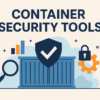How confident are you that your containers are secure all the way from code to deployment? If you’re relying solely on perimeter defenses or traditional scanning after builds are complete, you’re taking a serious risk.
The way we build, ship, and run applications has changed. CI/CD pipelines are now the norm, and containers sit right at the heart of that process. But they’ve also become a target. Fast-moving workflows mean mistakes get shipped just as quickly as features, and attackers know it.
Container security tools aren’t optional anymore in today’s pipelines. They’re a critical part of building and deploying safely.
The Speed of CI/CD Comes at a Cost
CI/CD pipelines are designed for speed and automation. Developers push code, automated tests run, containers are built, and deployments happen in minutes or even seconds.
That efficiency is great for productivity, but it also introduces some big challenges:
High volume of changes
Code, configs, and dependencies are updated frequently, increasing the attack surface.
More components involved
Containers pull from various sources including third-party libraries, base images, and public registries.
Lack of visibility
Once built, containers are often treated as black boxes. Without the right tooling, it’s difficult to understand what’s inside.
Inconsistent policies
Without enforcement baked into the pipeline, security policies might be bypassed or applied unevenly.
Even a small misconfiguration or outdated package can lead to serious vulnerabilities. That’s why waiting until runtime or post-deployment scans is too late.
What Container Security Tools Actually Do
A container security tool will integrate directly into your CI/CD workflows to analyze, enforce, and monitor security standards. They provide continuous visibility from development through production, helping teams catch problems early and respond quickly. Here are the main ways they help protect your environment:
- Image scanning – Identify known vulnerabilities in base images, OS packages, libraries, and dependencies before containers are shipped.
- Policy enforcement – Prevent containers from being deployed if they violate predefined security rules, such as using deprecated base images or running as root.
- Secret detection – Flag credentials, tokens, or sensitive data accidentally committed into code or container files.
- Configuration validation – Analyze Dockerfiles, Kubernetes manifests, and other configs to catch insecure defaults or misconfigurations.
- Runtime monitoring – Track container behavior in production, spotting unusual activity that could signal an attack.
By combining these capabilities, security tools close the gap between development and security, aligning teams around shared visibility and control.
Why Traditional Security Measures Fall Short
Traditional security practices often rely on perimeter defenses, post-deployment scanning, or manual checks. That approach made sense when deployments were infrequent and monolithic. It doesn’t work in a container-first, CI/CD-driven world.
Here’s what gets missed without purpose-built container security tools:
- Transitive vulnerabilities buried in layers of third-party packages
- Secrets embedded in build-time environments that make it into final images
- Misconfigured permissions that expose containers to privilege escalation
- Non-compliant dependencies being pulled in automatically from public sources
- Dangerous defaults like unencrypted traffic, no resource limits, or open ports
By the time these are discovered, the container is often already deployed, active, and potentially exposed.
Building Security Into the Pipeline
Waiting until the end of the process to think about security leads to rushed fixes, technical debt, and long-term risk. Container security tools solve this by embedding security into the CI/CD process itself.
Here’s what that looks like in practice:
- During build – As containers are created, images are scanned and policies are applied. If anything is flagged, the build fails.
- Before deploy – Deployments are validated against security policies, making sure only compliant containers are promoted.
- In production – Container behavior is monitored for anomalies. Any drift from the known-good configuration can trigger alerts or automatic remediation.
This shift-left model makes security a routine part of development, not a last-minute barrier. It also supports compliance by logging all activity and ensuring consistent standards across teams and environments.
Why It’s More Than Just Prevention
It’s not just about blocking threats. Container security tools also create smoother workflows, clearer accountability, and more efficient collaboration across teams.
Developers get fast feedback while they code. Security teams keep policies consistent without being disruptive. Ops teams gain trust in what’s running in production. Everyone works better when security is baked in, not bolted on at the end. That shift changes the culture. Security stops being a chore and becomes part of how things get done.
What to Look For in a Container Security Tool
Not all tools are created equal. The best ones slot neatly into your pipeline, handle scanning with speed and accuracy, and give visibility without slowing anyone down.
You want flexibility without complexity. Policies should be easy to manage. The interface should make sense. And runtime insights should show exactly what’s happening without creating noise.
If it feels clunky, your team won’t use it. If it’s invisible and reliable, they’ll rely on it.
Who’s Responsible?
It’s easy to point fingers. But container security isn’t one team’s job anymore.
Developers own the code. Ops owns the infrastructure. Security owns the policies. The only way it works is together.
Tools help by creating shared visibility. Everyone can see what matters. Everyone knows where the gaps are. That alignment builds trust and makes secure delivery repeatable.
Don’t Wait for the Alarm
Too many teams only take container security seriously after something goes wrong. A failed audit. A production incident. A breach. By that point, it’s too late to be proactive.
The good news? Adding container security doesn’t have to be disruptive. When integrated early, it becomes just another part of the build process. It runs quietly, checks what matters, and lets good containers flow through.
Future-Proofing Your Pipeline
Modern delivery isn’t slowing down. New builds. New deployments. More services. More complexity. Without proper security, that pace becomes dangerous.
The right container security approach gives you control without friction. You stop problems before they spread. You cut risk without cutting speed. You stay ahead of the next issue instead of scrambling to catch up.
This is no longer optional. It’s the foundation for building fast, staying secure, and scaling with confidence.








